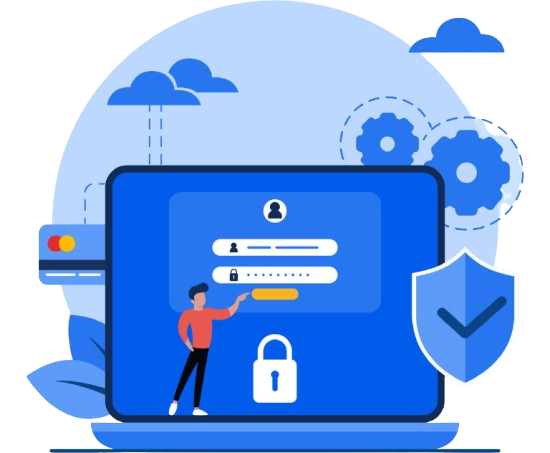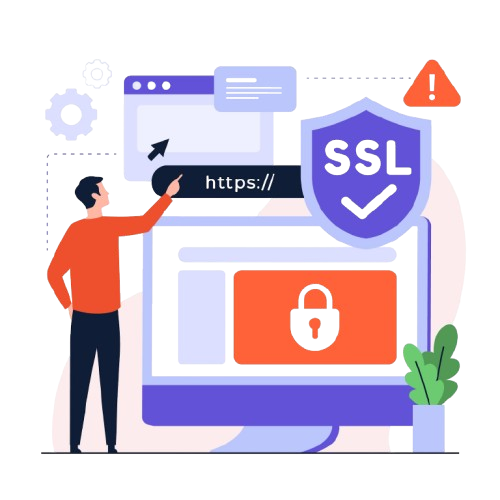An SSL (Secure Sockets Layer) Certificate is a security credential that confirms your website’s identity and encrypts any data exchanged between your site and its visitors.
3 Easy Steps to DDoS Protection
Follow these simple steps to see how it works
Real-Time Traffic Monitoring
Our system continuously tracks all incoming requests to your servers, websites, and networks—detecting unusual spikes or suspicious activity that could signal a DDoS attempt.
Detection & Attack Analysis
Intelligent algorithms quickly recognize harmful traffic patterns, pinpoint the source, and examine the attack type—ensuring accurate mitigation without disturbing legitimate users.
Automatic Protection & Mitigation
Our defense system instantly deploys DDoS protection tools, filtering out malicious traffic while letting genuine visitors through—keeping your site safe and available at all times.
Advanced DDoS Defense for Layers 3, 4 & 7 –
End-to-End Infrastructure Protection
Multi-layered defense designed to protect your servers, networks, and applications from every angle.
Instant Detection
Quickly spots and identifies DDoS attacks across both application and network layers.
Intelligent Traffic Filtering
Separates harmful traffic from genuine requests, ensuring seamless performance.
Automated Mitigation
Blocks malicious traffic instantly with minimal disruption.
Comprehensive Layer Protection
Guards against SYN floods, UDP floods, and complex HTTP/S-based attacks.
Scalable Security
Flexible protection built for startups, mid-size businesses, and large enterprises.
24/7 Surveillance
Round-the-clock monitoring with instant response to threats.
Customizable Rules
Create tailored filtering policies to match your unique traffic needs.
Attack Insights
Detailed post-attack analytics and reporting for full visibility.
Top Reasons to Choose a DDoS
Mitigation Provider
Safeguard business continuity with proactive defense and intelligent threat protection.

Why Your Business Needs Professional DDoS Mitigation Services
In today’s digital world, DDoS attacks are not only more common but also increasingly sophisticated.
Smart Traffic Filtering
Blocks malicious requests while ensuring genuine users enjoy uninterrupted access through advanced filtering and rate control.
Anycast Routing
Distributes traffic globally, reducing overload risks and absorbing large-scale DDoS attacks efficiently.
Cloud-Powered Mitigation
Redirects requests through scalable cloud infrastructure to filter threats and maintain high availability during attacks.
Behavioral Analytics
Continuously monitors traffic behavior to spot anomalies and stop threats before they impact your systems.
How Visitors See Your
Site With & Without SSL
Connection between browser and server.

With SSL
- Secure connection between browser and server
- Creates a trusted environment for website visitors

Without SSL
- Connection is not encrypted
- Browsers like Chrome mark all HTTP pages as “Not Secure”
How Visitors See Your
Site With & Without SSL
Connection between browser and server.
Why Do You Need an SSL Certificate?
SSL certificates are essential for online security. They establish an encrypted connection, ensuring that data is transmitted securely between a user’s browser and a website or server.
- Creates a secure link between browser and server
- Encrypts data to safeguard sensitive information
- Shows a padlock next to your website address
- Verifies your organization’s identity

We Are Here To Help You
Find answers to the most common questions about SSL Certificates
What exactly is an SSL Certificate?
Why should I use SSL on my site?
SSL ensures that private details like personal info, payment data, and passwords are securely encrypted during transmission from your customer’s device to your web server.
Will SSL work on every browser?
Yes, SSL certificates are supported by all widely used web browsers.
How can I apply for an SSL Certificate?
After purchasing an SSL, you’ll need to complete a quick validation with the certificate authority. Just follow the steps outlined by your SSL provider to get started.
How do I set up my SSL once it’s issued?
Once your certificate has been approved, it will appear in your account dashboard. You can then install it on your server by following the installation steps provided by your host.
When should I reissue my SSL Certificate?
Reissuing is necessary whenever your business or domain information changes and needs to be reflected on the certificate.
Can I switch to a higher SSL type later?
At this time, SSL certificates cannot be upgraded or downgraded once they have been issued.
Do I need technical skills to install SSL?
Not really—most providers give simple instructions, and some even handle the setup for you. You just need to follow a few easy steps to complete the installation.
